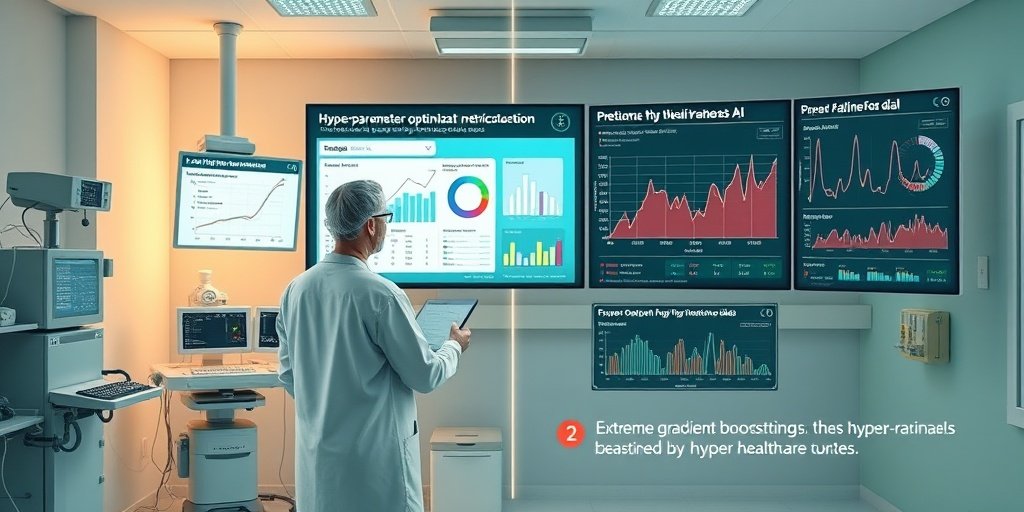⚡ Quick Summary
This study compared nine hyper-parameter optimization (HPO) methods for tuning an extreme gradient boosting model aimed at predicting high-need high-cost health care users. The results showed that hyper-parameter tuning improved model discrimination from AUC 0.82 to AUC 0.84 and enhanced calibration significantly.
🔍 Key Details
- 📊 Dataset: Randomly sampled training dataset for model training and validation.
- ⚙️ Technology: Extreme gradient boosting model.
- 🔍 HPO Methods: Included random sampling, simulated annealing, Bayesian optimization, and more.
- 🏆 Performance: Default model AUC 0.82; tuned models AUC 0.84.
🔑 Key Takeaways
- 📈 Hyper-parameter tuning is crucial for improving model performance in machine learning.
- 💡 All HPO methods tested led to similar improvements in model discrimination.
- 🔍 Calibration of models improved significantly with tuning, achieving near-perfect calibration.
- 📊 Large sample size and strong signal-to-noise ratio contributed to the effectiveness of HPO methods.
- 🌍 Findings are applicable to other datasets with similar characteristics.
- 🤖 Machine learning continues to show promise in predicting healthcare needs effectively.

📚 Background
The use of supervised machine learning in clinical predictive modeling is on the rise, particularly for identifying patients who are high-need and high-cost. However, the performance of these models heavily relies on the careful tuning of hyper-parameters, which are critical for achieving optimal predictive accuracy. This study aims to explore various methods for hyper-parameter optimization to enhance model performance.
🗒️ Study
The research involved training extreme gradient boosting models using a randomly sampled dataset. The authors compared nine different hyper-parameter optimization methods, including random sampling and various Bayesian approaches, to determine their effectiveness in improving model performance for predicting high-need high-cost healthcare users.
📈 Results
The baseline extreme gradient boosting model, which utilized default hyper-parameter settings, demonstrated reasonable discrimination with an AUC of 0.82. However, after applying hyper-parameter tuning through any of the HPO methods, the model’s discrimination improved to AUC 0.84, with models achieving near-perfect calibration. This indicates that tuning not only enhances predictive accuracy but also improves the reliability of the model’s predictions.
🌍 Impact and Implications
The findings from this study have significant implications for healthcare analytics. By employing effective hyper-parameter tuning methods, healthcare providers can better identify patients who are likely to incur high costs, enabling more targeted interventions. This could lead to improved patient outcomes and more efficient allocation of healthcare resources, ultimately benefiting both patients and healthcare systems.
🔮 Conclusion
This study highlights the importance of hyper-parameter tuning in machine learning models, particularly in the healthcare domain. The consistent improvements in model performance across various HPO methods suggest that investing in these optimization techniques is worthwhile. As machine learning continues to evolve, further research in this area will be essential for enhancing predictive capabilities in healthcare.
💬 Your comments
What are your thoughts on the role of hyper-parameter tuning in healthcare predictive modeling? We would love to hear your insights! 💬 Leave your comments below or connect with us on social media:
Comparison of methods for tuning machine learning model hyper-parameters: with application to predicting high-need high-cost health care users.
Abstract
BACKGROUND: Supervised machine learning is increasingly being used to estimate clinical predictive models. Several supervised machine learning models involve hyper-parameters, whose values must be judiciously specified to ensure adequate predictive performance.
OBJECTIVE: To compare several (nine) hyper-parameter optimization (HPO) methods, for tuning the hyper-parameters of an extreme gradient boosting model, with application to predicting high-need high-cost health care users.
METHODS: Extreme gradient boosting models were estimated using a randomly sampled training dataset. Models were separately trained using nine different HPO methods: 1) random sampling, 2) simulated annealing, 3) quasi-Monte Carlo sampling, 4-5) two variations of Bayesian hyper-parameter optimization via tree-Parzen estimation, 6-7) two implementations of Bayesian hyper-parameter optimization via Gaussian processes, 8) Bayesian hyper-parameter optimization via random forests, and 9) the covariance matrix adaptation evolutionary strategy. For each HPO method, we estimated 100 extreme gradient boosting models at different hyper-parameter configurations; and evaluated model performance using an AUC metric on a randomly sampled validation dataset. Using the best model identified by each HPO method, we evaluated generalization performance in terms of discrimination and calibration metrics on a randomly sampled held-out test dataset (internal validation) and a temporally independent dataset (external validation).
RESULTS: The extreme gradient boosting model estimated using default hyper-parameter settings had reasonable discrimination (AUC=0.82) but was not well calibrated. Hyper-parameter tuning using any HPO algorithm/sampler improved model discrimination (AUC=0.84), resulted in models with near perfect calibration, and consistently identified features predictive of high-need high-cost health care users.
CONCLUSIONS: In our study, all HPO algorithms resulted in similar gains in model performance relative to baseline models. This finding likely relates to our study dataset having a large sample size, a relatively small number of features, and a strong signal to noise ratio; and would likely apply to other datasets with similar characteristics.
Author: [‘Meaney C’, ‘Wang X’, ‘Guan J’, ‘Stukel TA’]
Journal: BMC Med Res Methodol
Citation: Meaney C, et al. Comparison of methods for tuning machine learning model hyper-parameters: with application to predicting high-need high-cost health care users. Comparison of methods for tuning machine learning model hyper-parameters: with application to predicting high-need high-cost health care users. 2025; 25:134. doi: 10.1186/s12874-025-02561-x